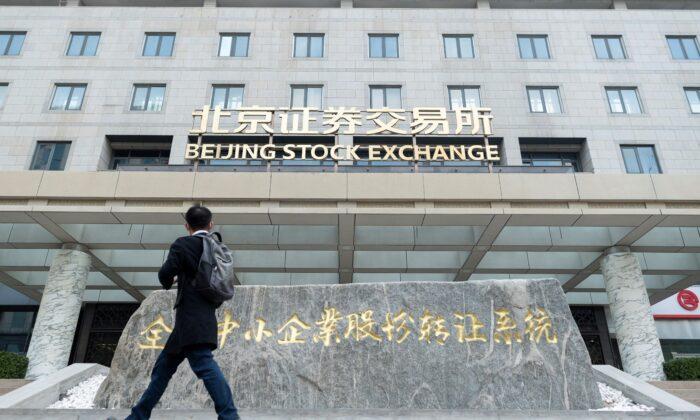Beijing’s recent measures to revitalize China’s plummeting stock markets have reportedly halted the market rout. However, the rescue efforts have hardly boosted foreign investors’ sentiments, indicating they may still be inclined to sell off Chinese stocks, analysts have said.
China’s economic outlook remains bleak, and most investors have said the crisis is structural rather than cyclical, as in prior market downturns.
As foreign investors become increasingly disenchanted with China’s sputtering economy, they are pulling out and betting on emerging markets such as India and Indonesia.
“There is clearly scope for more foreign selling [in China] ahead if sentiment remains weak as has been the case,” Nomura Securities stated in a client note released on Feb. 7 and viewed by The Epoch Times.
“Recent measures from China to support the stock market are welcoming and should likely stabilise markets, but for a sustained relief rally, we think China will need to address the core of investor concerns, i.e., property sector, economy and US-China relations,” it added.
According to Nomura, published data from Chinese regulators indicate that overseas investors continue to own 4.3 percent, or close to $390 billion, of Chinese equities, which, despite the recent sell-offs, is still higher than pre-pandemic (December 2019) levels of 3.6 percent, or $300 billion.
Although February numbers aren’t available yet, foreign investors sold a net 14.5 billion yuan (about $2 billion) in mainland Chinese shares in January, a month that saw 89.7 billion yuan (about $12.6 billion) in net selling, the sixth consecutive monthly outflow since August 2023, according to data provider Wind.
Moreover, reports have said the value of equities in China and Hong Kong was wiped out during the past three years, amounting to almost $6 trillion, making Chinese markets the world’s worst performers.
China’s current equity valuations—at about 8.5 times their aggregate projected earnings—are still risky, according to Nomura Securities.
“Fundamentally, we are yet to see signs of any stabilization in earnings,“ the global stock research firm said in its report. ”We have [also] been sensing a buyer’s strike which appears to have infected even domestic investors in Chinese stocks and bonds. [Hence,] calling the bottom in China stocks is a fool’s errand.”
Beijing Finds a Scapegoat
As the markets brace for this potential sell-off, Beijing, in a surprising move on Feb. 7, replaced Yi Huiman, the head of the watchdog China Securities Regulatory Commission (CSRC), with Wu Qing.Following the announcement, Gao Yuan, a widely followed retail investor, commented on social media platform X, “There’s the scapegoat: China’s securities regulator replaces chairman after the bloodbath in mainland stock market.”
The move is akin to a shake-up that happened during a sell-off in 2016. Mr. Wu, a veteran regulator who led the Shanghai Stock Exchange and a former deputy in the Shanghai municipal government, has a reputation for clamping down on traders.
In his previous oversight role in the mid-2000s, he ordered the removal of 31 stockbrokers for allegedly violating regulations.
Beijing didn’t provide a reason for removing Mr. Yi from his post, but some local investors considered the move as yet another desperate effort to stabilize the country’s stock markets that forced institutional and retail investors to cut their losses.
Amid this ongoing pressure, Beijing has pledged more help to prop up stock prices. These include, as reported by Bloomberg, a rescue package of 2 trillion yuan (about $278 billion) backed by offshore money to prevent a slump in its stock markets. The aim is to use the funds to stabilize the market by purchasing stocks onshore through Hong Kong markets.
In addition to the offshore funds, Chinese policymakers have set aside 300 billion yuan (about $41.8 billion) of local funds. These funds will be used to invest in onshore shares through state-owned financial firms, such as China Securities Finance Corp. or Central Huijin Investment Ltd.
Meanwhile, the CSRC has rolled out various policy moves. On Feb. 5, for example, the stock regulator said it would constantly monitor and take strong measures to minimize risks from pledged shares after the stock market fell to a five-year low.
At the end of January, the regulator also ceased lending of restricted shares. Another key measure made by the stock regulator in September 2023 was to enhance the inspection of program trading to increase control of computer-generated algorithms in stock trading.
Battered Chinese equities closed their most successful week in more than a year on Feb. 8, following a leadership transition at the market regulator and a series of supportive measures from Beijing.
The blue-chip CSI 300 Index closed with a 0.6 percent gain at 3,364.93 points on Feb. 8, taking its weekly gain to 5.8 percent, its most impressive performance since November 2022, ahead of the Lunar New Year holiday week beginning on Feb. 9.
Analysts, however, don’t see the recovery as long lasting.
“China’s economy outlook remains weak, the middle-class is seeing income decline, and most investors see China’s problem as structural rather than cyclical as in previous market down-turns,” stock research firm Jeffries said in a client note on Feb. 8 viewed by The Epoch Times.
According to analysts, the world’s second-biggest economy is still grappling with slowing prices since early last year, a bad omen for the Chinese New Year.
In January, China’s consumer prices fell at the fastest rate in more than 14 years, while producer prices also dipped, reinforcing the fact that low confidence and deflationary threats are still plaguing the economy.
Significant Shift
Foreign investors have started pulling money out of China as they have started paying close attention to the more promising emerging markets economies, particularly India and Indonesia in Asia, Lazard Asset Management said in a client note released last month.“We believe emerging markets equities are becoming ever more attractive as it remains one of the most mispriced asset classes globally,” Lazard said.
India is projected to gain significantly from a demographic dividend, with roughly 80 percent of its population under the age of 50, and Indonesia’s economic prospects are increasing as it moves up the metals value chain, Lazard said, adding that beyond Asia, development potential is promising in Latin America, namely Brazil and Mexico.
According to Bloomberg, Morgan Stanley believes India’s stock market will be the third largest by 2030, with its weight in MSCI’s benchmark for developing-market shares reaching an all-time high of 18 percent. China’s stock market, in contrast, has fallen to its lowest level on record, at 24.8 percent last month.
The World Bank’s semi-annual Indonesia Economic Prospects report indicates that the country’s economic growth remains robust, with its GDP projected to grow by about 5 percent in the next two years.







